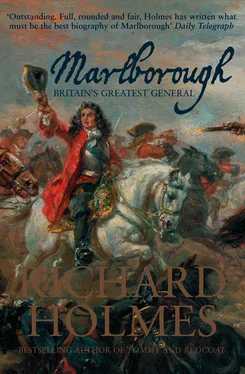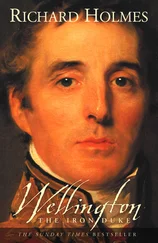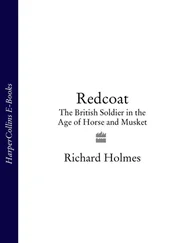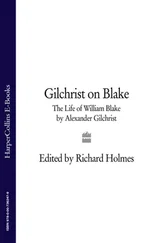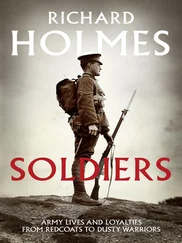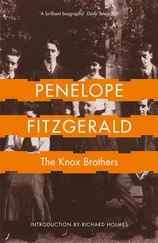Although James’s approach to his armed forces was but one aspect of his general policy, the importance of the army as a means of repression in both interregnum England and Louis XIV’s France gave it particular prominence. Monmouth’s rebellion had illustrated the frailty of county militias, and James allowed the militia to wither on the vine during his reign, a fact which may actually have worked to his disadvantage in 1688. He maintained his regular English military establishment at just short of 20,000, the figure it had risen to as a result of the rising. He did not substantially raise it till the spring of 1688, when he recalled the Anglo-Dutch brigade, sending one each of its regiments to England, Ireland and Scotland. With the fear of Dutch invasion that autumn he added extra troops to existing establishments and raised new regiments, giving his English army a theoretical strength of something over 34,000 men. Even this was not an unreasonably large force for a country the size of England: the French had some 100,000 regulars at the same time, and even little Hesse-Cassel had more than 10,000. 91 Such comparisons, however, were not uppermost in the minds of James’s parliamentary critics, who were reluctant to maintain the army even at its October 1685 size: this hostility led James to prorogue and eventually to dissolve Parliament.
The establishment of a Roman Catholic troop of Life Guards accorded with James’s policy of assisting his Catholic subjects as best he could, although the Earl of Ailesbury maintained that its captain was so venal that he would gladly have enlisted a Turk if he had the £40 entrance fee to hand. What caused more concern was James’s use of the prerogative to enable Catholic officers to serve, and indeed Sir Edward Hales, defendant in Godden v. Hales, was a colonel of infantry. Modern research has not identified that swelling torrent of Catholic officers described by some contemporaries, and even the 1688 expansion did not take the proportion above 11 per cent. There were, naturally enough, regimental exceptions: Sir Edward Hales’s Regiment had sixteen Catholics out of thirty-seven officers.
Perhaps more serious was James’s practice of depriving officers who opposed him in Parliament in 1685, or who subsequently crossed him, of their commissions. They were not always replaced with Catholics, but lost the money they had paid for their commissions, and he was thus ‘attacking the sanctity of property and acting without tact’. 92 Overall, between the spring of 1685 and the autumn of 1688 James had increased the size of the English army and done much to improve its efficiency. Yet in the process he had ‘disobliged’ many Protestant career officers. This might not, in and of itself, have turned them into rebels. But as they glanced across St George’s Channel, as Englishmen so often have, they saw a truly alarming process at work: the wholesale purging of the Irish army and its replacement by a Catholic force.
The Irish army was theoretically distinct from its English and Scots cousins. It was not only smaller and far worse equipped than the English army, but traditionally reflected the ascendancy of the Protestant minority over the Roman Catholic majority. James sought to reform it for two reasons: it urgently needed bringing up to date, and it was only fair, as he put it, ‘that the roman catholics, who had tasted so deeply of his sufferings, should now, in his prosperity, have at least a share of his protection’. 93 It would have been a dangerous enough task in the first place, and for James to entrust it to Dick Talbot, Earl of Tyrconnell and Sarah Churchill’s brother-in-law, made it explosive.
Tyrconnell, appointed lieutenant general in Ireland in 1685, and then lord lieutenant in place of Clarendon in January 1687, was the scion of an ‘old English’ family that had been settled in Ireland for centuries. Proud, prickly and presumptuous, he quickly set about dismissing Protestant officers from the militia and regular army alike and replacing them with ‘old English’ Catholic officers, and jettisoning Protestant rank and file in favour of Catholics. Robert Parker, one of the best witnesses for Marlborough’s campaigns, was a Protestant from Kilkenny who had joined the Irish army as a private in 1683, but in the summer of 1687 Tyrconnell held a great review on the Curragh of Kildare and young Parker found himself dismissed. He was on his way to join the Dutch army in 1688, but a chance encounter with his old company commander in London saw him back in the army after the Glorious Revolution, in Lord Forbes’ Regiment of Foot, later the Royal Regiment of Ireland. 94
We can be sure that it was never Tyrconnell’s plan to create an Irish Catholic army which could be shipped across to coerce the English. He was far more interested in redistributing power in Ireland, and it is even possible that, after the death of James II, he wished to declare Ireland an independent state. Although his ‘new modelling’ drew in a few experienced professional officers, it had little time to take effect, and so the Irish army of 1688 was in fact far worse trained than the force that Tyrconnell had begun to reform three years before. Moreover, even if James and Tyrconnell never intended to use the Irish Catholic army in England, Protestant Englishmen were wholly unconvinced. Yet again, as they saw it, property rights and religious sensibilities were trampled upon, and God alone knew where the business would stop. Even the London Gazette , the government’s own information organ, became infected by the prevailing sense of near-panic:
Bristol, March 6 [1688]. There are arrived in all these Western parts great multitudes of disaffected English protestants from Ireland, whose condition is most deplorable; from whom we have an account that at Dublin the Protestants were all disarmed. And their horses taken from them, and many of them plundered and cruelly treated by the soldiers, who had likewise seized both the cathedrals and the college; and all ships and passengers bound for England were stopped, and their goods and plate that was found on board taken away. In Munster, Leinster and Connaught the protestants are disseized of their inheritances, as well as plundered of their arms, horses and goods, and many of the chiefest amongst them imprisoned … 95
Just as Tyrconnell’s camps on the Curragh were intended to bring his army together for training (as well as to expel Protestants), so James’s annual military camps on Hounslow Heath had a purpose that was in part innocent. The heath, conveniently midway between Windsor and Whitehall, stood at the intersection of the Great West, Great North and Portsmouth roads, and an army based there could respond to landings in any direction. The camp also represented an opportunity to draw regiments together from individual garrisons and carry out standardised drill and some large-scale training. There was a mock fort, stormed regularly to the delight of spectators, and a chance for officers, when they could drag themselves away from London (captains were only expected to inspect their men every three days or so), to grasp the rudiments of An Abridgement of the English Military Discipline , a 1686 update of a drill-book first issued under Charles II. Simply getting regiments from across the land into camp on the right day showed the growing maturity of the army’s fledgling central administration, with William Blathwayt and his clerks coordinating arrivals. Once the troops were in camp, James personally took a close interest in their dress, drill and training.
There was more to Hounslow Heath than solid military preparation. The camp also served to show the City of London that there were troops near at hand, and there were, as John Evelyn tells us, ‘many jealousies and discourses of what was the meaning of this encampment’. 96 James saw the camp, at least in part, as a means of rattling the coercive power at his disposal in its scabbard. There were certainly times when he was prepared to use his army to dragoon opposition, and we should not be surprised that Londoners feared that they would be next. Trelawney’s Regiment was quartered in Bristol in 1685 and 1686 because of the city’s whiggish sympathy, and dragoons were posted to Lancaster, Warrington, Liverpool and Preston, though not in ‘the honest town of Wigan’. There were cases when soldiers arrived to help towns elect the right Members of Parliament, and were sometimes given voting rights to help the process along. 97
Читать дальше
